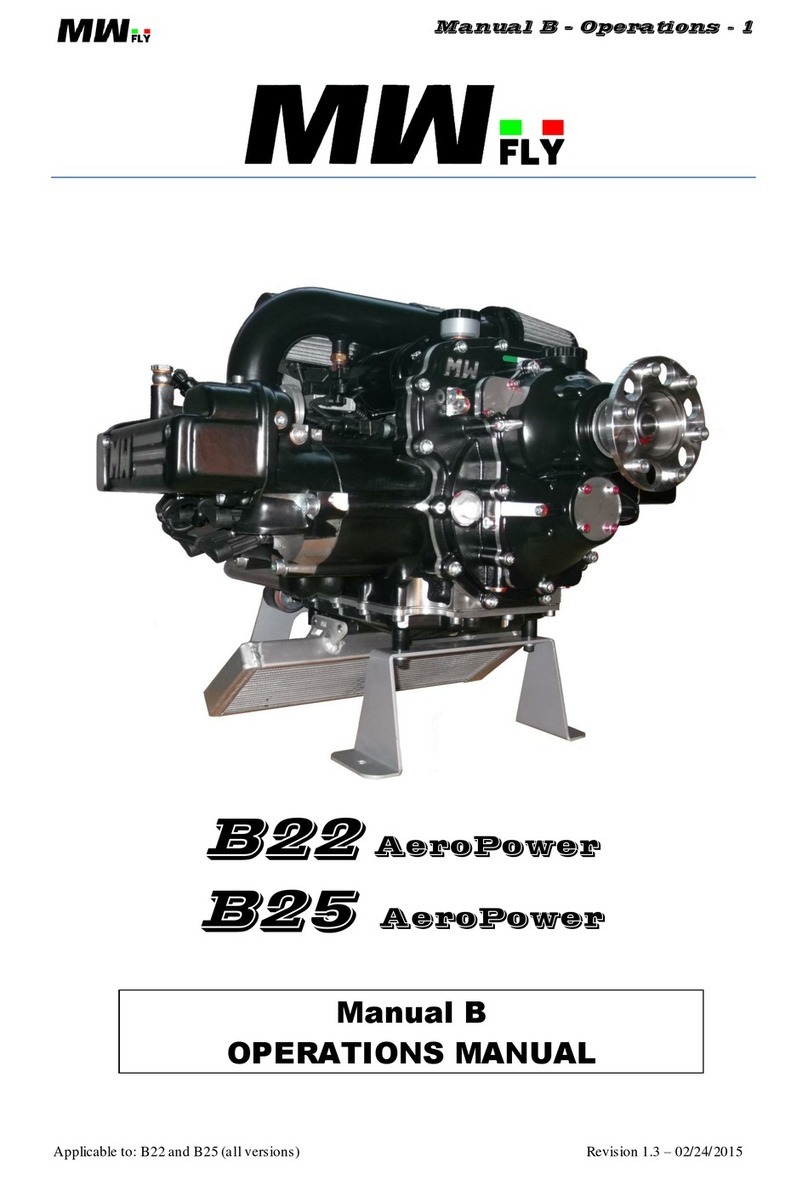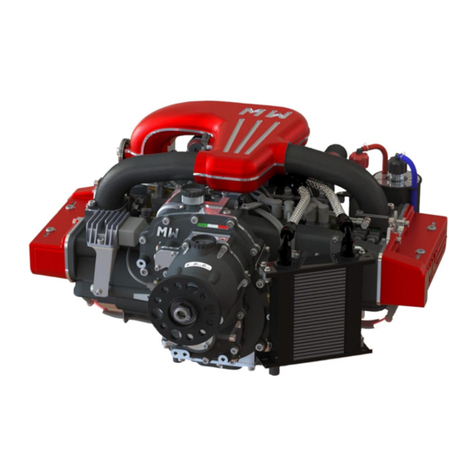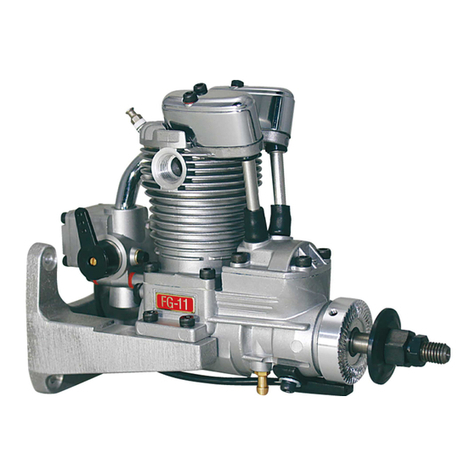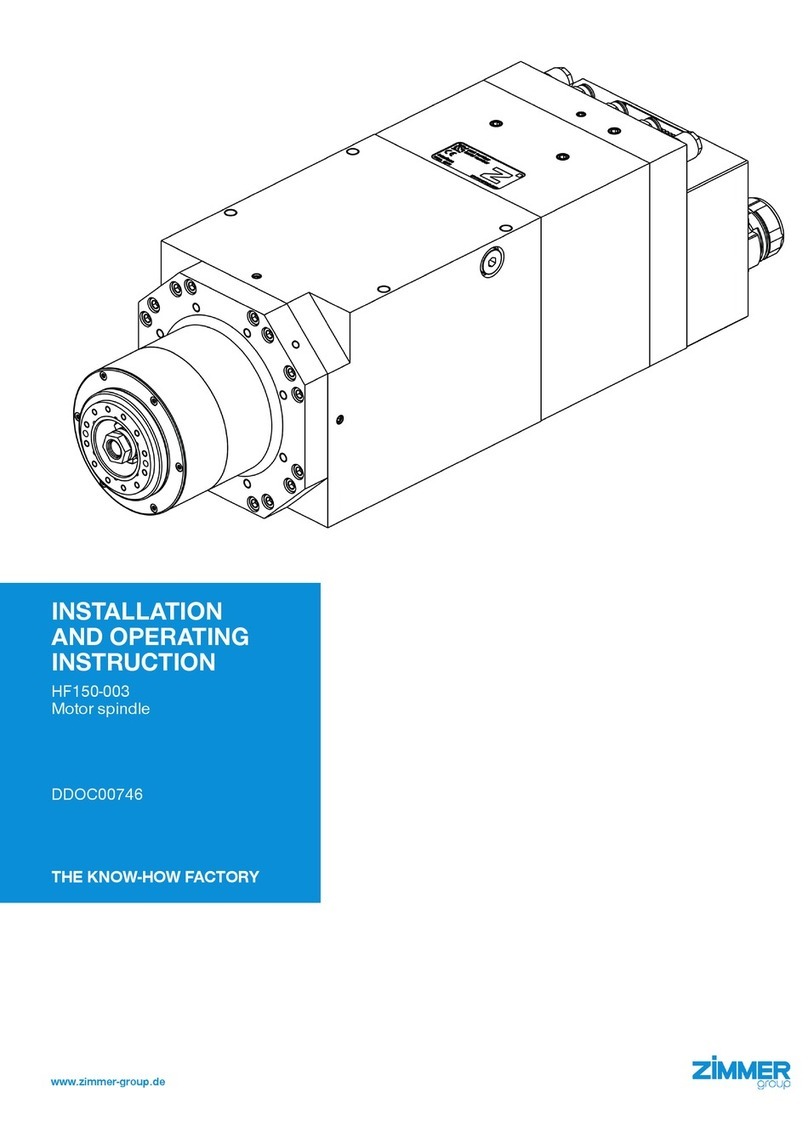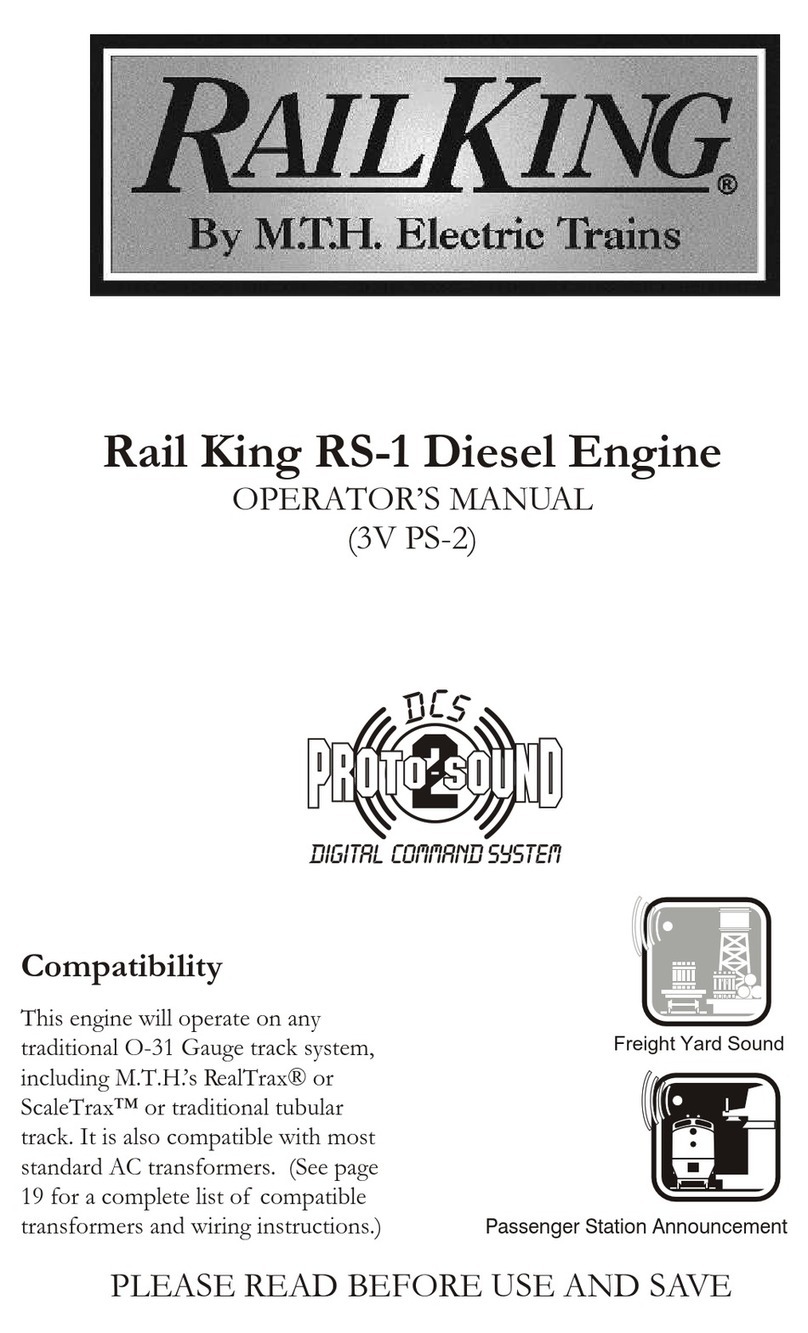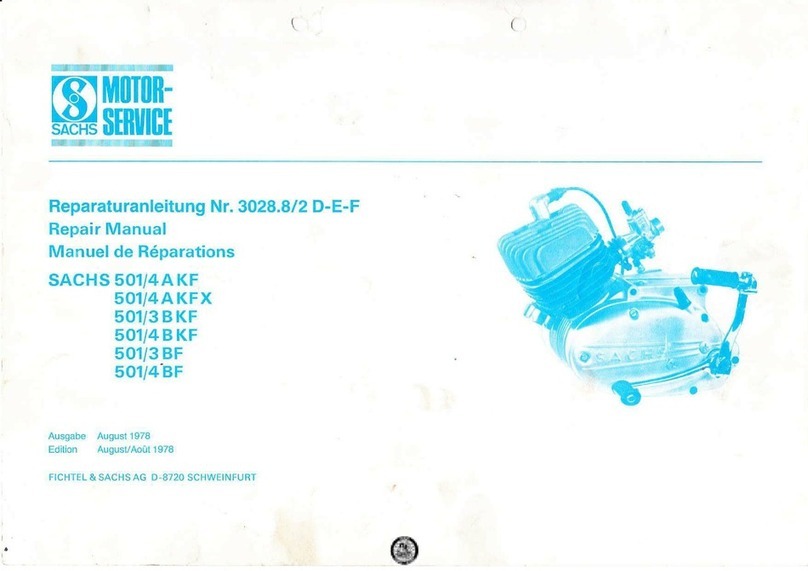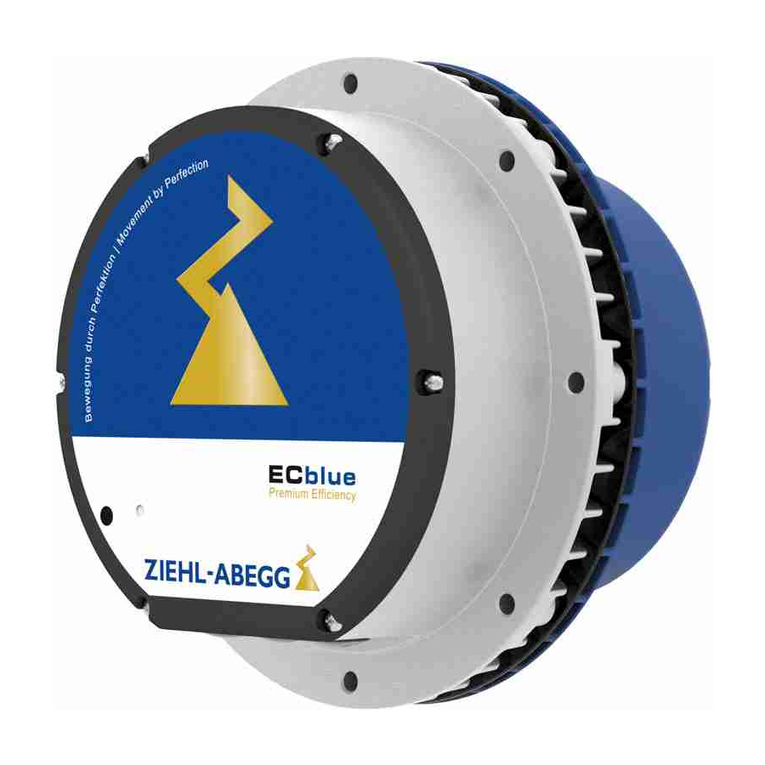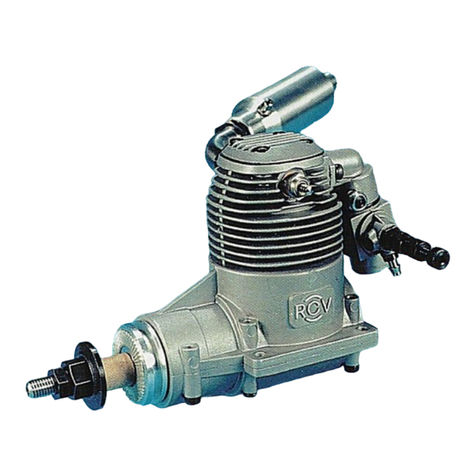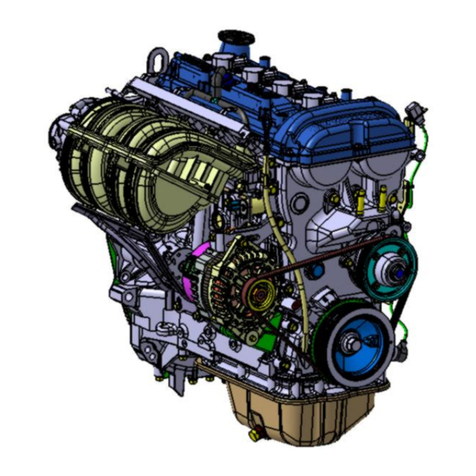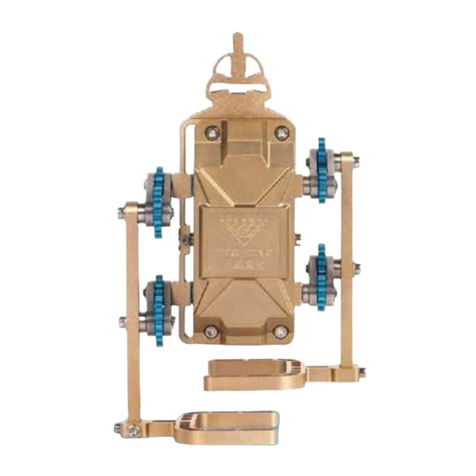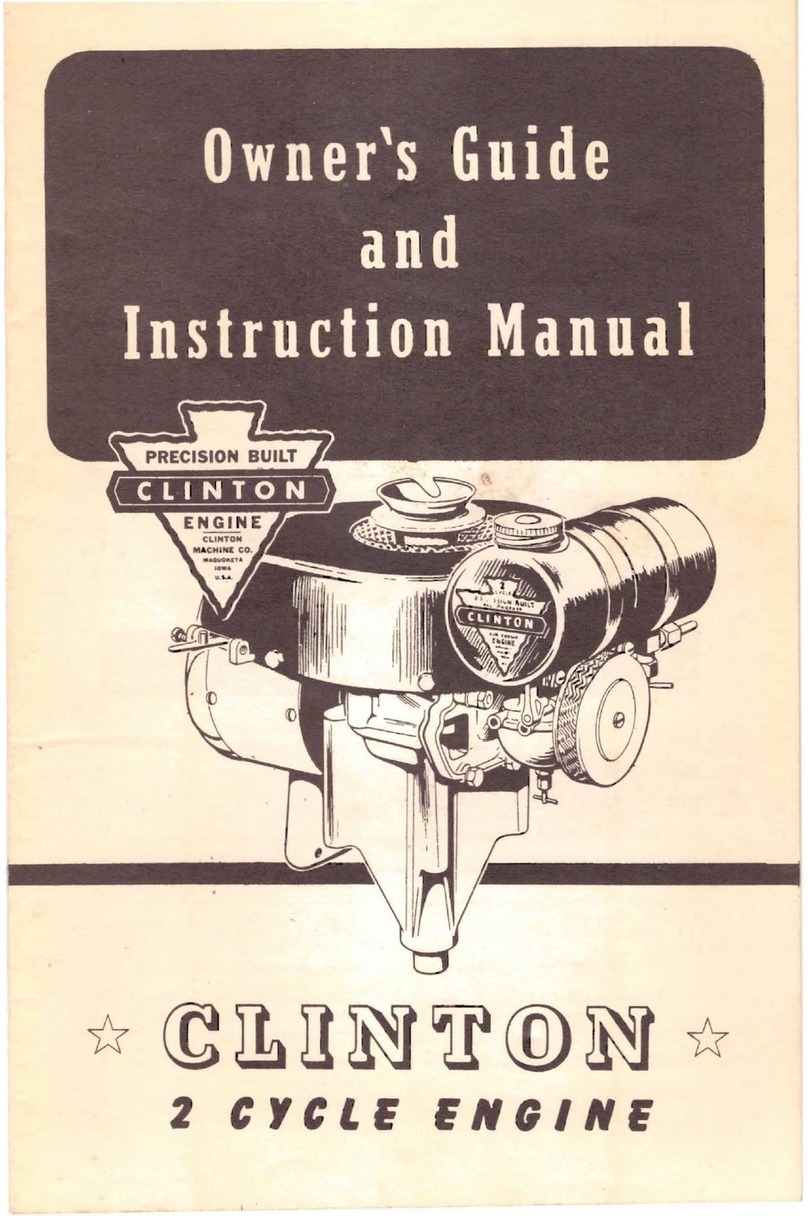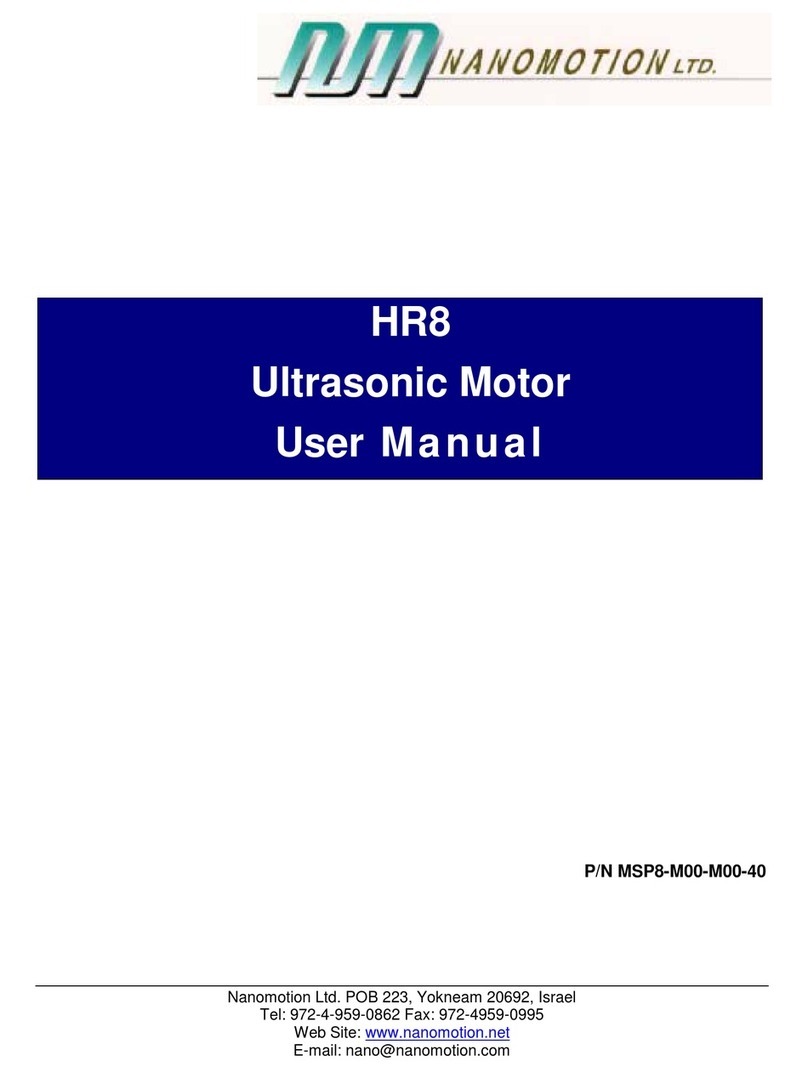MW Fly SPIRIT User manual

Operators manual for
SPIRIT engine
Document
E-DMB.E10.1
Edition Revision
A
1
TRANSLATED
FREE DISCLOSURE Page 1 of 102
OPERATORS manual for
SPIRIT engine

Operators manual for
SPIRIT engine
D
ocument
DMB.E10.1
Edition Revision
A
1
TRANSLATED
FREE DISCLOSURE Page 2 of 102
In-
flight use of the engine certifies that the user has read
and understood the contents of the installation manual and
the operating manual. Failure to follow the
instructions
contained herein can cause serious injury and even death.
Refer to the aircraft instruction manual for additional
information.
All information, illustrations, instructions and technical data contained in this
manual has been upgraded before printing. MWfly reserves the right to
modify, correct or upgrade general data at any time without any obligation
or prior consent from third parties. Publication of any part of this document
without written consent of MWfly is strictly prohibited.
This Manual forms part of the engine and must be kept safe. It must
accompany the engine in case of sale to a new owner. The original document
is written in Italian and this language will be used to settle any dispute of a
legal or technical nature.

Operators manual for
SPIRIT engine
D
ocument
E-DMB.E10.1
Edition Revision
A
1
TRANSLATED
FREE DISCLOSURE Page 3 of 102
INDEX
01 INTRODUCTION 6
01-01 Premise 6
01-02 Notes for consultation 6
01-03 Identification data 9
01-04 MWfly authorized service centers 9
02 SAFETY 10
02-01 Premise 10
02-02 Security elements 10
02-02-01 Passive safety elements 10
02-02-02 Active safety elements 12
02-03 Warning labels 14
02-03-01 Engine oil cap 14
02-03-02 Gearbox oil cap 15
02-03-03 Gearbox oil level arrow 15
02-03-04 Adapter 15
02-03-05 Governor 16
02-03-06 Expansion tank 16
02-03-07 Water circuit arrow 17
02-03-08 Head cover 17
02-03-09 Fuel circuit arrow 17
02-04 Use of technical documentation 18
03 ENGINE DESCRIPTION 19
03-01 General characteristics 19
03-02 Versions available 19
03-03 Name of cylinders and location of parts 20
04 TECHNICAL FEATURES 22
04-01 Intended use 22
04-02 Performance 22
04-02-01 Spirit 100 Direct R/L 25
04-02-02 Spirit 115 Direct R/L 27
04-02-03 Spirit 135 Direct R/L 29
04-02-04 Spirit 160 Direct R/L 31
04-02-05 Spirit 122 PSRU R/L 33
04-02-05 Spirit 135 PSRU R/L 35
04-02-07 Spirit 140 PSRU R/L 37

Operators manual for
SPIRIT engine
D
ocument
E-DMB.E10.1
Edition Revision
A
1
TRANSLATED
FREE DISCLOSURE Page 4 of 102
04-02-08 Spirit 160 PSRU R/L 39
04-02-09 Performance variation 41
04-03 Fuel consumption 42
04-03-01 Spirit 100 Direct R/L 45
04-03-02 Spirit 115 Direct R/L 47
04-03-03 Spirit 135 Direct R/L 49
04-03-04 Spirit 160 Direct R/L 51
04-03-05 Spirit 122 PSRU R/L 53
04-03-06 Spirit 135 PSRU R/L 55
04-03-07 Spirit 140 PSRU R/L 57
04-03-08 Spirit 160 PSRU R/L 59
04-04 Lubricant consumption 61
04-05 Propeller RPM 61
04-06 Propeller rotation direction 62
05 DESCRIPTION OF THE SYSTEMS 64
05-01 Cooling system 64
05-02 Lubrication system 65
05-03 Fuel system 66
05-04 Electrical system 68
05-04-01 EM-m instrument 69
06 OPERATING INSTRUCTIONS 70
06-01 General operating limits 70
06-01-01 Engine revolutions 70
06-01-02 Fuel pressure 72
06-01-03 Engine oil pressure 72
06-01-04 Manifold Pressure (MAP) 73
06-01-05 Engine oil temperature 73
06-01-06 Gearbox oil temperature 73
06-01-07 Coolant temperature 74
06-01-08 Inlet Air Temperature (IAT) 74
06-01-09 Contingency 75
06-01-10 Tilt angles 75
06-01-11 Electric voltage 76
06-02 Operating fluids 77
06-02-01 Cooling liquid 77
06-02-02 Engine oil 77
06-02-03 Gear oil 77
06-02-04 Fuel 78

Operators manual for
SPIRIT engine
D
ocument
E-DMB.E10.1
Edition Revision
A
1
TRANSLATED
FREE DISCLOSURE Page 5 of 102
06-03 General criteria of use 79
06-03-01 Checks before starting 79
06-03-02 Startup 82
06-03-03 Heating 84
06-03-04 Before takeoff 84
06-03-05 Take off 85
06-03-06 Cruise 86
06-03-07 Landing 86
06-03-08 Shutdown 86
06-03-09 Use in winter weather 87
06-04 Behavior in an emergency 89
06-04-01 Accidental stop - Start during flight 89
06-04-02 Overspeed 89
06-04-03 Exceeding the maximum cooling temperature 90
06-04-04 Exceeding the maximum lubricant temperature 90
06-04-05 Oil pressure below the in-flight limit 90
06-04-06 Low oil pressure on the ground 90
06-04-07 Fuel pressure below flight limit 91
06-04-08 Low fuel pressure on the ground 91
06-04-09 Battery voltage too high 91
06-04-10 Battery voltage too low 92
06-04-11 Injection alarm 93
06-04-12 Generator alarm 93
06-04-13 Abnormal vibrations 94
06-04-14 Erratic operation 94
07 ENGINE CHECKS 95
07-01 Tool kit list for pre-flight or emergency checks 95
07-02 Preservation and recovery of service after prolonged inactivity 95
07-03 Engine protection for use in harsh climates 95
08 TROUBLESHOOTING 97
08-01 Operating anomalies and their resolution 97
08-02 Malfunctions in the injection and ignition systems 99
08-03 Communication of operating anomalies 100
09 SIGNATURES AND LIST OF REVISIONS TO THE DOCUMENT 102

Operators manual for
SPIRIT engine
D
ocument
E-DMB.E10.1
Edition Revision
A
1
TRANSLATED
FREE DISCLOSURE Page 6 of 102
01 INTRODUCTION
SPIRIT engines have been designed and built using the most modern engine
technology, with the aim of obtaining good performance combined with a high level
of passive safety. With proper use, they will give you years of enjoyment and reliable
service.
Read this manual carefully before using the engine and apply all the safety rules
contained therein, as well as those suggested by experience and common sense.
Remember that regular maintenance and a thorough inspection before take-off are
essential safety factors.
MWfly will be happy to provide you with further information and all the assistance you
may need.
01-01 Premise
The purpose of the operating manual is to help familiarize yourself with the operating
and safety instructions related to the use of the engines. Before using the engine, it
is therefore necessary to understand all the contents of this manual.
If any passage is difficult to understand or in case of doubts, please contact MWfly or
an authorized center in writing, requesting clarifications.
For further and more detailed information, please also consult the installation manual,
the ordinary maintenance manual and the extraordinary maintenance manual. It is
also necessary to summarize the contents of this chapter with what is prescribed and
recommended by the aircraft manufacturer as well as suggested by one's own
experience.
This engine has not received any certification for suitability
for aeronautical use.
Its use is intended exclusively for experimental or non-
certified aircraft, on which a possible engine failure does not
compromise flight safety.
Use the propeller in accordance with the rules and laws in force.
01-02 Notes for consultation
The original language of drafting of this document is Italian: Italian is the reference
language for any dispute.
The manual is divided into chapters; each chapter is divided into sections; each
section is divided into paragraphs; within each paragraph there may be a further

Operators manual for
SPIRIT engine
D
ocument
E-DMB.E10.1
Edition Revision
A
1
TRANSLATED
FREE DISCLOSURE Page 7 of 102
subdivision into topics. The title of each chapter, section, paragraph or topic is
highlighted as follows.
CHAPTER
Section
Paragraph
Subject
The numbering of the contents of the manual is made up of an alphanumeric code
which follows the following criterion.
CC-SS-PP
Where:
CC indicates the chapter of the document
SS indicates the section of the document
PP indicates the paragraph of the document
The names of the figures and tables show the chapter number and a progressive
number, followed by the letter P for the figures and by the letter C for the tables (e.g.
07-03-P). The measurement system used in the manuals is the technical system (ST);
in the tables, the unit of measurement of the quantities represented is indicated
enclosed in square brackets [].

Operators manual for
SPIRIT engine
D
ocument
E-DMB.E10.1
Edition Revision
A
1
TRANSLATED
FREE DISCLOSURE Page 8 of 102
The triad of
reference
axes used in the manual is
a right-
hand triad that
originates on the helix
axis, at the intersection
with the propeller support
plane: the x axis
originates on the flange
support plane itself and is
positive in direction of the
engine, the y axis
is
positioned with origin on
the propeller centerline
and is positive in the
direction of bank #1, the z
axis originates on the
propeller axis, and is
positive upwards, intake
manifold side.
The symbols used in the manuals are as follows.
Warning: Indicates an instruction which, if ignored, could
result in serious personal injury or death.
Caution: indicates an instruction the non-observance of which can
cause serious damage to the propulsor, causing its possible
unwanted stop.
INFORMATION: provides additional information useful for
completing or fully understanding an instruction.
1., 2., ... This numbering is used to list tools and consumables needed to perform
an installation or maintenance operation; it is also used to group in parts
lists or engine components highlighted in illustrations.
a., b., … This numbering is used to list installation or maintenance operations with
an inclusion relationship: all actions or options listed must be verified.
o This symbol is used to list installation or maintenance operations with an
exclusion relationship: only one of the listed actions or options must be
checked.
This symbol is used to list general engine characteristics, component
specifications, or installation and maintenance options.
(…) A text included in brackets clarifies an aspect, or constitutes an example
or a reference to a chapter of the same or of another document.
01
-
01
-
P

Operators manual for
SPIRIT engine
D
ocument
E-DMB.E10.1
Edition Revision
A
1
TRANSLATED
FREE DISCLOSURE Page 9 of 102
01-03 Identification data
The engine serial number is
stamped on the
top of the
engine, near the gearbox. It
consists of the model
identification code (check in
table 03-01-
C of this manual)
followed by a six-
digit number,
the first four of which indicate
the serial number and the last
two the year of manufacture.
01-02-P
Modifying or eliminating this code causes the immediate revocation of the guarantee
and releases MWfly from any obligation towards the user.
For each request for information or spare parts it is necessary to indicate the serial
number of the engine.
01-04 MWfly authorized service centers
For further information on maintenance or spare parts service, please contact the
nearest MWfly assistance center (www.mwfly.it).

Operators manual for
SPIRIT engine
D
ocument
E-DMB.E10.1
Edition Revision
A
1
TRANSLATED
FREE DISCLOSURE Page 10 of 102
02 SAFETY
02-01 Premise
Reading this manual alone is not sufficient to eliminate all dangers associated with
the installation and use of the propeller. However, the understanding and application
of the information contained therein is essential to use the engine properly and safely,
reducing the causes of potential risk.
The information, instructions, description of components and systems, as well as
illustrations and technical data contained in this manual are correct at the date of
publication of the revision. MWfly keeps its products constantly updated, and any
changes to parts of the engine must be understood in this sense, without forcing the
user to update what has been purchased: if this eventuality occurs, MWfly, through
its distribution and assistance network and through the website www. mwfly.it, will
disclose the mandatory nature of any update.
The choice to install and use this engine is entirely subject to the discretion and
responsibility of the aircraft manufacturer, assembler and owner: MWfly cannot
guarantee the suitability for use of the engine on any specific type of aircraft due to
the variety of design and project to which the aircraft themselves are subject; for this
reason MWfly is not responsible, nor can it issue any form of guarantee, regarding
components, accessories or parts of the aircraft that may be damaged during
installation or operation of the engine. The user assumes all risks deriving from the
use of the propeller and acknowledges that he is aware of the above.
MWfly reserves the right to make changes at any time, without notice and without
incurring any obligation. No part of this publication may be reproduced without written
permission.
02-02 Security elements
In order to better understand each aspect, it is important to divide the concept of
safety into two large subsets: passive safety and active safety.
02-02-01 Passive safety elements
Passive safety concerns engine design and installation criteria. Listed below are some
focal points.
Monolithic connecting rod: reduces the possibility of crankshaft failure, often
caused by positioning or tightening errors of the connecting rod cap.
Pistons machined from solid: greater safety and non-deformability induced by the
absence of intrusions from fusion, stresses from molding and the use of an alloy
with a low coefficient of thermal expansion.
Overhead camshaft: makes the use of hydraulic tappets (suitable with pushrod
and rocker arm distribution) unnecessary, eliminating the risk of valve breakage
in the event of a drop in oil pressure. Furthermore, this solution reduces the

Operators manual for
SPIRIT engine
D
ocument
E-DMB.E10.1
Edition Revision
A
1
TRANSLATED
FREE DISCLOSURE Page 11 of 102
dynamic loads on the distribution control, allowing less friction and less wear on
the kinematic mechanism, at the same time improving the precision of the control.
Gearbox with separate lubrication: increases the reliability of the transmission,
reducing the risk of fatigue failure or wear from pitting of the teeth.
Propeller shaft with front cam flexible coupling: reduces torsional loads on the
propeller shaft and on the transmission system, drastically limiting the possibility
of fatigue failure of the shaft itself.
ADC torsional damping system: facilitates starting and stopping the engine,
reducing the torsional load on the starting system and transmission components.
The ADC system is free from periodic maintenance or adjustments.
Electronic ignition and injection system: significantly reduces the risk of icing of
the intake duct due to the absence of the venturi tube, eliminates the risks
deriving from the accumulation of petrol in the carburetor bowls (since they are
not present) and i.e. the switching off of the engine during take-off due to
forgotten fuel cock closed or aircraft fire in the event of rollover due to fuel leaking
from the carburetors; improves engine performance, reducing fuel consumption.
Pre-installed, high-quality electrical harness: Reduces the risk of electrical failures
and difficult setups of home-built systems.
Pre-installed fuel circuit: the advantage is created by the absence of perishable
and heat-sensitive rubber pipes in favor of small-section metal pipes, which are
not very sensitive to vibrations and, being non-deformable, do not create a gush
effect in the event of break.
Automatic fuel pump: the command comes from the control unit and provides
that, with the engine off, the pump also switches off immediately to prevent fuel
leakage in the event of an accident. Furthermore, the pump is of the "non-
transparent" type to eliminate the possibility of petrol leaking from the tanks with
the pump stopped (and therefore with the engine stopped).
Entirely liquid cooling: improves the distribution and constancy of temperatures
inside the engine and avoids the development of complicated air intakes. Liquid
cooling also makes it possible to obtain real performance that is always very close
to the rated performance, thanks to the constant thermal regime of the engine.
Metal coolant passages: eliminates the possibility of detachment and degradation
of the fittings.
Pre-installed thermostat: avoid exposing the engine to useless thermal shocks;
allows for shorter warm-up phases.
Pre-installed expansion tank: reduces the risk of breakage of the hydraulic circuit
and consequent overheating of the engine.
Semi-dry sump: the safety advantage is due to the fact that the presence of oil in
the sump is ensured by the force of gravity and by the presence of appropriate
containment bulkheads; in the case of a dry sump, on the other hand, a possible
vent from the engine gaskets would prevent the oil from returning to the collecting
tank, as there is no necessary pressure in the sump.

Operators manual for
SPIRIT engine
D
ocument
E-DMB.E10.1
Edition Revision
A
1
TRANSLATED
FREE DISCLOSURE Page 12 of 102
Downward Exhaust Manifold Outlet: Reduces the risk of burns or overheating of
engine components due to tortuous exhaust routes.
Certification of production materials and heat treatments.
Non-destructive testing of details considered vital for safety purposes and their
traceability.
Assembly carried out according to aeronautical standards, with end-of-line
verification of the performance of each engine.
Ease of installation: improves safety as there are fewer pre-flight checks to
perform and with excellent accessibility.
Engine wall mount: reduces the number of threaded couplings between engine
and aircraft, to the advantage of safety.
Complete endoscopic inspection of all the internal components of the engine: this
peculiarity allows to keep the operating status of the engine under control, without
carrying out any disassembly of parts, nor the disassembly of the engine from the
aircraft.
02-02-02 Active safety elements
Active safety concerns the way to use the engine and to carry out its maintenance
operations. Below we report some important advice, suggested by common sense
and the usual rules of prudence, without however being able to include all the
situations or behaviors that constitute opportunities for potential risk.
Frequently check engine mounting, flight controls, fuel lines,
electrical section and filters.
Never refuel with the risk that it may fall on hot engine
components. Always use approved fuel containers, using the
utmost caution in transport.
Never pour fuel in an enclosed area, or where fumes could
reach the ignition point.
Never run the engine indoors. The exhaust fumes contain
carbon monoxide, a particularly poisonous gas which, if
inhaled in excessive quantities, rapidly causes loss of
consciousness and death.
Never use this engine in unfavorable weather conditions
(strong wind, rain, fog, etc.), at high altitudes or in places
that may make an emergency landing difficult in the event
of a sudden stop of the thruster. The engine is intended for
daytime use only.

Operators manual for
SPIRIT engine
D
ocument
E-DMB.E10.1
Edition Revision
A
1
TRANSLATED
FREE DISCLOSURE Page 13 of 102
Always carry out a proper inspection before starting the
engine: this helps to prevent accidents or damage. In case
of doubts about the state of efficiency of the propeller, give
up the flight.
On the ground, in the presence of observers, use the engine
with caution and make sure you have a complete view of the
danger zone.
Never leave the aircraft while the engine is running.
This engine is not suitable for aerobatic flying.
Always keep the engine in perfect working order by following the
maintenance table contained in the ordinary maintenance manual
and performing the coupons at the envisaged intervals.
Write down any operating anomaly in the engine logbook. Never fly
before solving the problem and noting the correction in the logbook.
For the use of the engine and the aircraft, scrupulously comply with
all national and local laws and regulations.
Never exceed the maximum number of revolutions foreseen.
Do not start the engine
without the propeller: this can cause serious
damage to the engine.
Never use propellers with a moment of inertia greater than that
specified: this eventuality releases MWfly from any liability and
from any guarantee obligation.
This powerplant has not received any certification for aeronautical
use, nor does it conform to any aeronautical standard. Its use is
intended exclusively for experimental or non-certified aircraft, on
which a possible engine failure does not compromise flight safety.
The user assumes all risks deriving from the use of the propeller
and acknowledges that he is aware of the above.

Operators manual for
SPIRIT engine
D
ocument
E-DMB.E10.1
Edition Revision
A
1
TRANSLATED
FREE DISCLOSURE Page 14 of 102
Before starting the engine, make sure that each component of the
same is firmly anchored, so as to prevent its involuntary loss in
flight.
Never operate the engine
with an inadequate amount of oil in the
crankcase or reduction gear.
Before switching off the engine, wait a few minutes, essential to
make the temperatures of the various components uniform,
avoiding unwanted distortions.
The propeller must only be used by trained and qualified users for
the purpose, as well as informed on the potential dangers deriving
from its use.
This operating manual is part of the technical documentation and
must be integrated with the installation manual, the ordinary
maintenance manual, the extraordinary maintenance manual and
with the illustrated spare parts catalogue. When reading this
manual, pay attention to references to other manuals.
If there are discrepancies between what is specified in this manual and the legislation
in force, proceed according to the most stringent rule.
02-03 Warning labels
Some warning labels are applied to the engine, which show the top-ups to be made
before take-off, and other information regarding the operation and characteristics of
the engine. These labels are in English: below we report their meaning and the area
of application on the engine.
02-03-01 Engine oil cap
02-01-P
CAPACITY 2.85L
-
Capacity 2.85
liters
API SG OR HIGHER – Lubricant specification API
SG or higher (identifies lubricant quality
according to American Petroleum Institute
specifications)
ENGINE OIL – Engine oil
SAE 10W/40 – Thermal degree of the lubricant
10W/40 (for the choice of the most suitable oil
according to the climatic areas, consult the
installation manual)
CHECK BEFORE FLIGHT – Check the level before
each flight

Operators manual for
SPIRIT engine
D
ocument
E-DMB.E10.1
Edition Revision
A
1
TRANSLATED
FREE DISCLOSURE Page 15 of 102
02-03-02 Gearbox oil cap
02-02-P
CAPACITY 0.4L – Capacity 0.4 liters
API GL-5 OR HIGHER – Lubricant specification
API GL-5 or higher (identifies lubricant quality
according to American Petroleum Institute
specifications)
GEAR OIL – Transmission oil
SAE 80W/90 – Thermal grade of lubricant
80W/90
CHECK BEFORE FLIGHT – Check the level before
each flight
This warning label is not present on versions without gearbox.
02-03-03 Gearbox oil level arrow
02
-
03
-
P
The arrows on the side of the gearbox identify
the
gearbox oil levels screw.
02-03-04 Adapter
The label is located on the top of the gearbox and bears the name of the torsional
damping system adopted on engines of the AeroPower series (B.5.5).
02-04-P
ACTIVE DAMPING CONTROL –
Active control of
torsional vibrations on starting and stopping.
The label is not present on versions without gearbox.

Operators manual for
SPIRIT engine
D
ocument
E-DMB.E10.1
Edition Revision
A
1
TRANSLATED
FREE DISCLOSURE Page 16 of 102
02-03-05 Governor
Engines with reduction gear can be equipped with constant speed governor with
electro-hydraulic operation (A.15.1.2.). In this case the presence of the governor is
indicated by the sticker positioned on the pump cover in the front part of the reducer.
02
-
05
-
P
PROP GOVERNOR INSIDE –
Internally mounted
propeller governor
FULLY INTEGRATED ELECTRO-HYDRAULIC –
Integrated electro-hydraulic system
02-03-06 Expansion tank
02-06-P
USE ETHYLENE GLYCOL ONLY –
Use only
ethylene glycol
(avoid using propylene glycol or
unmixed water)
FILL TANK UP TO 2/3 –
Fill the expansion vessel
to 2/3 of its capacity
CHANGE COOLANT EVERY 2 YEARS –
Replace
the coolant every 2 years
RESERVOIR –
Indicates the closure cap of the
expansion vessel (not pressurized)
PRESSURIZED –
Indicates the closing cap of the
cooling system (pressurized)
CAPACITY 0,7 L –
Capacity of the expansion
vessel 0.7 liters
CHECK COOLING SYSTEM AND
LEVEL BEFORE
FLIGHT –
Check the cooling system and coolant
level before each flight
NEVER OPEN WHEN HOT –
Do not open when
the engine is hot (referring to the pressurized
cap)

Operators manual for
SPIRIT engine
D
ocument
E-DMB.E10.1
Edition Revision
A
1
TRANSLATED
FREE DISCLOSURE Page 17 of 102
02-03-07 Water circuit arrow
02
-
07
-
P
The arrows are placed near the
water pump inlet
and outlet manifolds, and identify the direction of
flow in the manifolds themselves. In particular, the
lower manifold sends the coolant to the radiator,
the upper manifold receives the coolant from the
radiator to send it to the pump. Ot
her arrows are
placed near the holes for the cab heating circuit to
indicate the direction of flow.
02-03-08 Head cover
02
-
08
-
P
The stickers are placed on the upper part of the
cylinder head covers, and identify the cylinders
according to the numbering shown in section 4.3.
CYL1 – cylinder number 1
CYL2 – cylinder number 2
CYL3 – cylinder number 3
CYL4 – cylinder number4
02-03-09 Fuel circuit arrow
02
-
09
-
P
The arrows are placed on the fuel shunt, and
identify the direction of the
fuel flow at the inlet and
outlet of the shunt. In particular, the lowest port
identifies the pressurized fuel inlet to the shunt, the
highest port identifies the fuel outlet from the shunt
for return to the tanks.

Operators manual for
SPIRIT engine
D
ocument
E-DMB.E10.1
Edition Revision
A
1
TRANSLATED
FREE DISCLOSURE Page 18 of 102
02-04 Use of technical documentation
The technical documentation and the directives are to be considered the necessary
tool for personal training, but they cannot in any way replace an adequate specific
instruction, both theoretical and operational.
The information provided in the following manuals report procedures and checks that
can be implemented by qualified professionals working in the sector under normal
operating conditions.
DMA.E10 - Installation manual: contains the information necessary for the correct
installation of the engine.
DMB.E10 - Operating manual: contains the information required for the intended
use of the engine.
DMC.E10 - Routine Maintenance Manual: Contains information necessary to
properly perform scheduled maintenance.
DMD.E10 - Extraordinary maintenance manual: contains the information
necessary for carrying out unscheduled maintenance, i.e. determined by
breakdowns.
DME.E10 - Illustrated spare parts catalogue: contains the list of spare parts and
accessories provided.
DSL.E10 - Service letter: contains information intended to improve the product or
the use of the same.
DSB.E10 - Service bulletin: reports the replacements, checks or warnings to be
applied by the indicated deadline.
The illustrations in this manual do not represent the details of the propeller in detail,
but provide an indication of their function and structure: for these reasons it is not
possible to deduce dimensional information or verify details from the published
illustrations.
All further documentation that may be necessary is in any case available at MWfly
authorized assistance centers.

Operators manual for
SPIRIT engine
D
ocument
E-DMB.E10.1
Edition Revision
A
1
TRANSLATED
FREE DISCLOSURE Page 19 of 102
03 ENGINE DESCRIPTION
03-01 General characteristics
4-cycle stroke
4 boxer cylinders
Distribution with single overhead camshaft (SOHC), chain and gear drive, bucket
tappets with upper register pad, 2 valves per cylinder
Liquid cooling system with double involute pump, expansion vessel and integrated
thermostat, circulation ducts in stainless steel
Forced lubrication system with trochoidal pump, semi-dry sump with integrated
ducts
Electronic ignition mapped to inductive discharge, with thermal and altimetric
adjustment
Mapped electronic double injection power supply, with thermal and altimetric
adjustment
CAN bus system for data transmission
Fuel system with electric fuel pump with automatic safety control and auxiliary
pump, pressurized circuit with steel pipes and integrated pressure regulator
Integrated reduction unit with separate splash lubrication, helical tooth gears,
predisposition for hydraulic propeller pitch control (not present in versions without
reduction unit)
Front cam dissipative torsional damping system with return springs
ADC system (Active Damping Control) antikickback in starting and stopping
Starting system with electric starter, integrated contactor, oil-centrifugal
decompressor and safety clutch
Charging system with oil-cooled permanent magnet generator and external
current regulator
03-02 Versions available
The direction of rotation of each engine version (both with reduction gear and direct)
is defined with respect to an observer located in front of the propeller, who sees the
engine behind it, according to the SAE J824 standard: therefore a propeller that moves
in a clockwise direction it makes a right rotation (right “R” engine), a propeller that
moves in an anticlockwise direction makes a left rotation (left “L” engine). Each engine
model can use either pulling or pushing propellers.

Operators manual for
SPIRIT engine
D
ocument
E-DMB.E10.1
Edition Revision
A
1
TRANSLATED
FREE DISCLOSURE Page 20 of 102
The following table summarizes the main characteristics of SPIRIT engine.
Name Code
Max
power
[hp]
Max power
continuous
[hp]
Maximum
engine
revolutions
[rpm]
Max
propeller
shaft rpm
[rpm]
Spirit 100 Direct L/R
W011/W012 100 100 3500 3500
Spirit 115 Direct L/R
W013/W014 115 115 3500 3500
Spirit 135 Direct L/R
W017/W018 135 120 4750 4750
Spirit 160 Direct L/R
W023/W024 160 142 4750 4750
Spirit 122 PSRU L/R
W015/W016
122 110 4250 2450
Spirit 135 PSRU L/R
W019/W020 135 115 4750 2425
Spirit 140 PSRU L/R
W021/W022 140 125 4250 2450
Spirit 160 PSRU L/R
W025/W026 160 137 4750 2425
03-01-C
In addition to the ones listed above, further versions can be made upon customer
request: the complete list is available in a separate document.
03-03 Name of cylinders and location of parts
The designation of the cylinders is the one shown in the following figure, and is the
same for both right-hand and left-hand rotation engines. Looking at the engine from
above with the prop flange up, cylinder #1 is first on the top right, cylinder #2 is
second on the right, cylinder #3 is first on the top left, and cylinder #4 the second on
the left; bank #1 (cylinders #1 and #2) is on the right and bank #2 (cylinders #3
and #4) is on the left.
Other MW Fly Engine manuals

